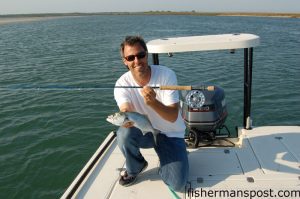Cape Fear On The Fly – Afternoon Blues

Gary Hurley, Fisherman’s Post Publisher, with a bluefish caught in a local inlet channel on a Clouser. The bluefish is the first tally in the 2011 countdown series “Cape Fear on the Fly” with Capt. Jon Huff of Circle H Charters.
Although not nearly as glamorous or prized as many species of saltwater fish, the bluefish can prove to be a challenging quarry to pursue with a fly rod. They show up in good numbers in our area this time of year and can readily be caught using a variety of fishing techniques.
Blues will provide great light tackle action, and they’re always a welcome sight after a long inconsistent winter season, especially for novice anglers and kids. Bluefish are some of the toughest fighters you can tangle with, and when you can find blues over five pounds you would be hard pressed to find anything that will pull harder, pound for pound.
And that brings us to this installment of “Cape Fear on the Fly,” where Gary Hurley and I are seeking out many of the species that are available to fly anglers here in the Cape Fear region and then sharing our successes and near successes right here in the Fisherman’s Post.
As soon as I was catching bluefish on a consistent basis, I called Gary and we agreed on an afternoon jaunt to a favorite deeper channel inside a local inlet (sorry no GPS coordinates) and began trolling small diving plugs (Rapala X-Raps) to try and locate concentrations of fish.
As we had hoped, we started getting bites almost immediately near an exposed sand bank and decided to beach the boat and get “warmed up” while standing on dry land. I had rigged my favorite 9 wt fly rod with a floating line and 16 lb. Rio tapered leader where I had attached a 12 inch section of 25 lb. Knot too Kinky titanium leader (or bite tippet as it is called in the fly fishing world).
Single strand stainless wire or small flexible braided cable will both work, but the titanium leader knots easily and does not kink and, therefore, will allow multiple catches before re-rigging becomes necessary. An Albright knot is a great connection for attaching wire to the tapered leader, and a simple loop knot is perfect for attaching the fly to the leader.
Our fly setup for bluefish was completed with a #2 Clouser in olive and white. Clouser patterns are simple and effective and may well be the single most widely used fly in saltwater fishing. Gary grabbed this outfit and walked down the beach a bit as I rigged up a second outfit, a 7 wt with an intermediate line to fish a little deeper in the water column.
I tied up a similar leader and loop knotted on a pearl-colored Gummy minnow fly about 3 inches long in #2 size as well. This fly, in my opinion, resembles a Glass Minnow as closely as any fly you could throw, and it’s a favorite to use for many other species like false albacore and spanish mackerel.
I jumped out of the boat and walked down the beach. I heard Gary hoot and looked to see him come tight to something and let myself think, “Wow this might be easy!” Then just like that the hook pulled and we lost what was probably our first small blue.
We fished on the beach as the tide started to rise, casting out and letting our flies sink and swing with the light current, but after 15 minutes or so and no other bites we decided to troll again to locate some more fish. It didn’t take long as we had a couple more trolling bites almost immediately just off the same bank. So we anchored up-current of an 8-10 foot deep hole and set up on the stern of the boat to cast across the current, paying out line and letting the tide carry our fly back as far down current to where we had our bites.
Using this technique we were able to “cheat” the wind and gain much more distance on our casts, rather than trying to punch a backcast into the substantial wind.
After I had demonstrated a few casts and short, fast stripping retrieves, Gary took over on the stern, and in no time at all was fast to a decent blue! Congratulations were in order as we netted our first fish of the trip and snapped a few pictures for proof. Even a bluefish, that at times can be almost too easy to catch, felt like an accomplishment on the fly rod.
We didn’t get any more bites in that spot, so we anchored up in a few more of my favorite locations, and I managed to hook another one but pulled him off halfway to the boat.
The fish were around and were relatively easy to catch on lipped plugs, but the sun was starting to set and we decided to head in. I think maybe a sinking line would have helped get the fly down deeper to where we got most of the bites, and I am currently looking for a fly to carry in Intracoastal Angler that will be close to foolproof.
But nonetheless, if you want to polish up your fly fishing skills and have a good chance at catching some hard fighting fish on the long rod, get out and chase some blues. They won’t let you down.
Tight loops, and thanks for reading!
Capt. Jon Huff
Capt. Jon Huff is owner operator of Circle H Charters, an inshore fly and light tackle guide service based out of Wrightsville Beach. Jon splits his time between running inshore charters, fishing offshore tournaments, and co-managing Intracoastal Angler. (910) 617-2619, www.circlehcharters.com
